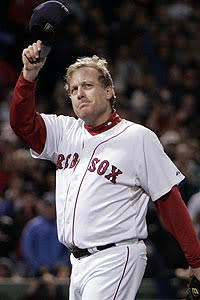Curt assessment
BOSTON – Here is one of the unimagined consequences of the Steroid Era, that Curt Schilling now rates a better chance of being elected to the Hall of Fame than his one-time idol, Roger Clemens.
It has long been a part of the Schilling oeuvre, that he was an underachieving, unfocused mediocrity until Clemens, then just coming off his third Cy Young Award, gave him an earful during an off-season workout in Houston in 1991, telling the 25-year-old Schilling he was wasting his talent.
''It was like getting a third eye,'' Schilling would say later. ''I looked at the game with a whole new approach, outlook, respect. I just realized that I couldn't continue to do things the way I had done them and put my head on the pillow at night and say I'd done everything I could. There was just so much more that I could do.''

Schilling's 20-year career included pitching for Baltimore, Philadelphia, Houston, Arizona and Boston.
(AP Photo/Winslow Townson)
Now, with Schilling making his retirement official and Clemens facing possible indictment in connection with his alleged steroids use, the pupil's case for hardball immortality is almost certain to receive more sympathetic scrutiny than that of the mentor. Schilling himself, in the aftermath of the Mitchell report detailing steroid allegations against Clemens, blogged that unless Clemens could clear his name, anything he accomplished in the last decade of his career – including four more Cy Young Awards – should be disregarded.
There are seven pitchers from the Steroid Era who are locks for the Hall of Fame (barring any future untoward revelations): Randy Johnson, Greg Maddux, John Smoltz, Pedro Martinez, Tom Glavine, Mariano Rivera and Trevor Hoffman. Maddux and Glavine are 300-game winners, Johnson is five wins short, and has nearly 5,000 strikeouts. Hoffman is the all-times save leader, Rivera the closer with an unrivaled resume of postseason dominance. Smoltz is the only pitcher in history with 200 or more wins and 150 or more saves. Martinez's .687 winning percentage is the highest among active pitchers, and he might have had the greatest four-year stretch (1997-2000) ever.
Schilling strictly by the numbers does not draw as compelling a Hall of Fame portrait as those seven – the last pitcher to be voted in with fewer wins than Schilling (216) was Don Drysdale (209), 25 years ago. But ultimately, he belongs in their company, and it goes beyond throwing his bloody sock into the debate.
Teammates and opponents who disliked Schilling – and their number is legion – used to mock him as "red-light Curt'' for his propensity never to shy away from TV cameras. But it is indisputable that when the spotlight burned brightest, Schilling was at his best. He came to Boston to win a World Series – he had a bonus written in his Red Sox contract that kicked in only if they won a Series – and delivered in his first year. The clause was illegal, but MLB mistakenly approved it, a triumph for a guy who consulted "Negotiating for Dummies" while Theo Epstein, the brainy Red Sox general manager, sat in his living room.
(When the Red Sox were trying to sell Schilling on coming to Boston, they compiled a video study of Clemens, the pitcher whose style was most comparable to his, and brought it to Schilling's Arizona home to show him that he, too, could succeed in Fenway Park.)
The "bloody sock" game, in which Schilling vanquished the Yankees in Game 6 of the 2004 ALCS after team doctor Bill Morgan practiced on a cadaver to find a way to repair Schilling's shredded ankle tendon, is the stuff of legend (and some misinformed cynicism). More importantly, it is also emblematic of a postseason record second to none: Schilling was 11-2 with a 2.23 ERA in October, a .846 winning percentage unmatched by anyone else with 10 or more decisions. He came through for three different teams – he was the MVP of the 1993 National League Championship Series for the Phillies, was pitching for Arizona when he dueled Clemens and the Yankees in Game 7 of the "Mystique and Aura" World Series of 2001, and was a part of two World Series winners in Boston, a team that had gone 86 years since winning a title until Schilling arrived.
Schilling's control, especially as a power pitcher, was remarkable: His 4.38 strikeout-to-walk ratio is the best in history; Martinez (4.14) is the only other pitcher to average at least four whiffs per walk. Schilling averaged 1.96 walks per nine innings, fourth among active pitchers and just behind Maddux (1.80), who also retired last winter.
Schilling ranks 15th all-time with 3,116 strikeouts – of the pitchers ahead of him who have appeared on a Hall ballot, only Bert Blyleven has been denied election, and maybe the Dutchman's star turn as pitching coach for the Netherlands in the WBC will finally, and deservedly, correct that historical blunder.
Perhaps Schilling won't have to wait as long, although he will meet resistance. Even though he won 20 games three times and was a six-time All-Star, the cumulative numbers fall short of others – like Mike Mussina, another recent retiree who finished with 270 wins. But Schilling was singular in his ability to perform on the biggest stage, and for that, he deserves his own plaque in Cooperstown.
